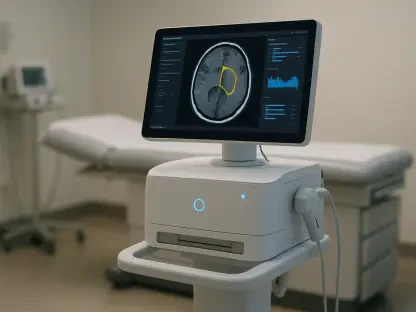The latest scientific research sheds light on the profound consequences of air pollution on human health, particularly on cardiovascular health, through the innovative use of magnetic resonance imaging (MRI). This research highlights a crucial link between prolonged exposure to fine particulate matter (PM2.5) and the onset of myocardial fibrosis, a form of heart muscle scarring. This connection suggests that air pollution plays a significant role in exacerbating heart disease risks, offering new insights into how environmental factors contribute to cardiovascular complications. By unraveling these connections, the study emphasizes the need for urgent public health measures and a deeper understanding of the intricate relationship between the environment and heart health.
Linking Air Pollution to Cardiac Scarring
Research Methodology and Observations
A pivotal study published in Radiology has delved into the effects of air pollutants on heart tissue remodeling, emphasizing the relationship between PM2.5 and myocardial fibrosis. Researchers from the University of Toronto used cardiac MRI technology to investigate heart tissue among 201 healthy individuals and 493 patients diagnosed with dilated cardiomyopathy. The use of MRI allowed for precise imaging of heart tissue, revealing significant myocardial alterations in those exposed to PM2.5 over extended periods. This study draws attention to how air pollution acts as a catalyst, instigating structural changes within the heart, beyond what is traditionally predicted by risk factors such as hypertension or smoking.
Significantly, the research highlights that even air pollution levels deemed safe by global standards are sufficient to trigger harmful cardiovascular changes. It was found that certain demographics, particularly women, smokers, and those with hypertension, exhibited more pronounced heart tissue scarring. This suggests a heightened vulnerability within these groups, emphasizing the need for targeted interventions in public health policies. The study further solidifies air pollution’s role not just as an aggravator of existing conditions but as a primary agent impacting cardiovascular health at a cellular level.
Implications for Cardiovascular Risk Assessment
Understanding air pollution’s impact on heart structure paves the way for more accurate cardiovascular risk assessments and management strategies. With cardiovascular diseases remaining a leading cause of mortality worldwide, identifying novel risk factors such as air pollution is critical for advancing preventative care. Current risk assessments often prioritize factors like lifestyle and genetic predispositions, potentially overlooking the insidious influence of environmental factors. The study underlines the need to incorporate long-term exposure considerations into health assessments for a more comprehensive approach.
This research calls for a paradigm shift in considering pollution’s role in cardiovascular health, advocating for public health initiatives aimed at reducing air pollution exposure. By integrating environmental exposure data into cardiovascular risk management, healthcare providers can offer more personalized preventive measures. Furthermore, understanding the disparities in air pollution exposure across different regions and demographics helps address health inequalities that stem from environmental factors. This study challenges healthcare systems to evolve, ensuring that environmental health risks are a central component of public health strategies moving forward.
Advancing Cardiovascular Health through Radiology
The Role of Radiology in Environmental Health
The growing role of radiology in assessing environmental impacts on health is underscored by the innovative application of MRI in this study. Radiologists are increasingly positioned at the frontlines of environmental health research, utilizing advanced imaging technologies to unveil the subtle, yet critical, effects of pollutants on organ systems. Through accurate imaging and diagnostics, radiologists can help quantify the impact of air quality on heart tissue, bridging a crucial gap in understanding the environmental determinants of chronic diseases.
By employing a cross-disciplinary approach, this study exemplifies the potential of radiology to enhance public health measures against air pollution. The insights gained from MRI findings not only inform medical professionals but also serve to guide policymakers in crafting effective environmental regulations. Radiology provides the tools needed to visualize the intricate effects of pollution, offering tangible evidence required to prompt necessary changes in legislation and public awareness campaigns. This expanding role positions radiology as a vital player in the realm of public health, pivotal to improving population health in response to environmental challenges.
Public Health Implications and Future Directions
The research findings advocate for a robust response to air pollution’s impact on health, urging the implementation of comprehensive public health strategies. Acknowledging the profound influence of air quality on heart disease, there is a clear call to action for reducing pollution levels, even those currently deemed safe. Effective public health initiatives could mitigate the cardiovascular impacts linked to pollution, especially among vulnerable populations exhibiting heightened susceptibility.
Future research endeavors should aim to deepen our understanding of the biological mechanisms underlying pollution-induced myocardial fibrosis. This could pave the way for targeted therapies designed to counteract the effects of environmental toxins on cardiovascular health. Additionally, advocating for stronger environmental regulations could lead to substantial health benefits, as reflected in reduced incidence of heart disease and related complications. Through integrated efforts that span research, clinical practice, and policy, there is a pathway towards a healthier future, one where environmental health is intrinsically linked to overall well-being.
Towards a Healthier Environment
Recent scientific breakthroughs have uncovered the serious impact of air pollution on human health, especially pertaining to cardiovascular conditions, with the aid of magnetic resonance imaging (MRI). This cutting-edge research uncovers a vital association between long-term exposure to fine particulate matter, known as PM2.5, and the development of myocardial fibrosis, which is a type of scarring on heart muscle tissue. This revelation highlights how air pollution significantly contributes to increasing heart disease risks, providing fresh perspectives on the influence of environmental elements on cardiovascular health issues. By delving into these links, the study stresses the urgency of implementing public health initiatives and gaining a comprehensive understanding of the complex interplay between environmental factors and heart health. This emerging evidence calls for immediate attention to reducing air pollution, aiming to mitigate its adverse effects on the heart and improve overall public health.









